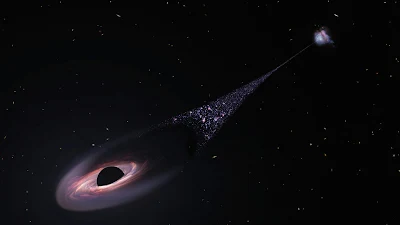🕳️ How Time Works Inside a Black Hole: Explained Simply
Time behaves in strange ways near black holes. The closer you get to a black hole, the slower time flows — and once you cross the event horizon, time essentially stops (from an outside observer’s point of view).
Let’s break this down simply, using Einstein’s theories and some mind-bending black hole physics.
🕰️ What is Time Dilation?
According to Einstein's theory of general relativity, time isn’t absolute. It's flexible — it can slow down or speed up depending on gravity and motion.
This effect is called gravitational time dilation.
Near massive objects like black holes, gravity is incredibly intense.
This warps spacetime, and as a result, slows time down.
Imagine watching someone fall into a black hole. You’d see them slow down… and almost freeze at the event horizon. But for them, they’d fall in normally.
🌀 The Event Horizon: Point of No Return
The event horizon is the invisible boundary around a black hole. Once something crosses it, nothing can escape — not even light.
From an external point of view, time stops at the event horizon.
For the falling object, time continues, but only from their own frame of reference.
It’s like time is split: stopped for the universe, but flowing normally for the traveler.
Black holes are cosmic whirlpools where gravity reigns supreme. They warp spacetime so drastically that even light cannot escape their pull. This extreme gravity also twists time itself in strange ways.
🧠 What Happens to Time Inside the Black Hole?
This is where things get weird. Once inside:
The laws of physics break down.
Time and space switch roles — meaning you move forward in space the same way we move forward in time on Earth.
There’s no turning back or standing still.
Inside a black hole, the future leads only one way — to the singularity, the core point of infinite density.
No one knows what actually happens at the singularity. It’s where our understanding ends.
🧭 Real-Life Implications
Gravitational time dilation isn’t just a theory. It’s been measured using satellites and atomic clocks. In fact, your head ages slightly faster than your feet, due to Earth’s gravity!
Black holes just take that effect to the extreme.
🧠 Final Thought
Black holes don’t just warp space — they warp time.
And the closer we get to understanding them, the closer we are to unlocking the deepest mysteries of the universe.
🔗 Related Reads to Expand Your Mind
🌌 Black Holes Explained: A Beginner’s GuideETRA SHOTS:
In theory, the falling object would appear to freeze and fade right at the edge, as if time itself stops at the horizon spaceyv.com. (In practice, we’d see it redshift into invisibility.)
To the distant observer, the infalling object never actually crosses the horizon; it just slows down, lingering at the brink.
Once you actually cross the event horizon, all bets are off. Inside the black hole, “space” and “time” swap roles.
The radial direction toward the center becomes timelike, meaning that moving inward is as inevitable as moving forward in time.
In other words, no matter how you try to escape or hover, you’re doomed to move closer and closer to the center as inexorably as time marches onward.As noted by physicists, once you pass the horizon, you cannot stop or reverse your plunge – it’s as impossible as stopping time or going back into the past.
Even light itself now points inward; there is literally no future that leads back out.
Inside the horizon, the concept of time as we know it breaks down at the singularity.
According to general relativity, as you approach the singularity at the black hole’s core, spacetime curvature becomes infinite, and our current physics can no longer predict what happens einstein-online.info.
From your own perspective, your clock would tick normally as you fall, but the journey from crossing the horizon to reaching the singularity takes only a finite (and possibly very short) time.
Essentially, inside a black hole, the “future” inevitably lies at the singularity. There is no turning back or lingering – just an inexorable march to the end of space and time as we understand them.
All of this is mind-bending but backed by Einstein’s equations. From outside, time dilation near a black hole leads to dramatic effects (a falling astronaut fades and redshifts near the event horizon).
From inside, the rules flip: the center becomes the future, and no signals (not even light) can escape.
While actual black holes likely include quantum effects beyond current theory, the classical picture is already enough to stretch our imaginations.
In any case, black holes remind us that time is not an absolute river – it can twist, stretch, and even end, depending on gravity’s pull.
The deeper lesson: our universe can behave very differently than our everyday experience suggests einstein-online.infoeinstein-online.info.











Comments
Post a Comment